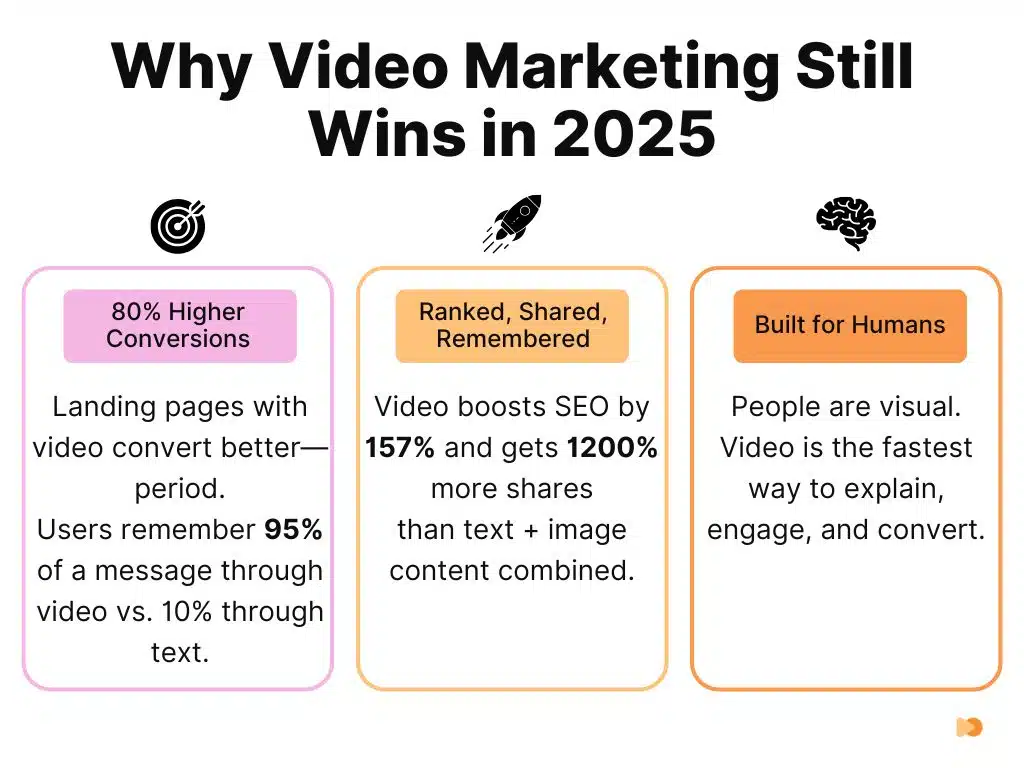Video marketing has become a key part of how businesses reach people online. In 2025, videos make up most of the content we see on the internet, with short clips grabbing quick attention and longer ones building deeper connections. This guide looks at the trends in video marketing, focusing on how short-form and long-form videos lead to success. You will find practical tips, real examples, and ways to use both types in your strategy. By the end, you will know how to pick the right format for your goals and measure what works.
Video content helps brands stand out in a crowded digital space. Short-form videos, like those on TikTok or Instagram Reels, are great for fast engagement. Long-form videos, such as tutorials on YouTube, offer more detail and help with trust-building. Trends show that mixing both can boost results, with short videos driving traffic and long ones turning viewers into customers. As attention spans shift, understanding these formats is crucial for any marketer.

What is Short-Form Video?
Short-form video refers to clips that last less than 60 seconds, often up to 90 seconds on some platforms. These videos are made to capture interest right away, fitting into busy lives where people scroll through feeds quickly. They use simple stories, fun music, and quick cuts to keep viewers hooked. In video marketing trends, short-form content leads because it matches how users consume media on mobile devices.
This format started with apps like Vine but grew big with TikTok, which changed how brands create content. Now, short-form videos focus on trends, challenges, and user interaction. They are easy to make with basic tools like smartphones, making them accessible for small businesses. The goal is to deliver value fast, whether it’s a tip, a joke, or a product demo, without wasting time.
Benefits of Short-Form Video in Marketing
Short-form videos boost engagement rates up to 2.5 times higher than long-form ones. They work well because people have short attention spans, around eight seconds, so quick content holds interest better. Brands see higher shares and likes, which helps spread their message organically. This leads to more visibility on algorithms that favor active content.
Another benefit is cost-effectiveness. You can produce these videos with minimal equipment, like a phone and free editing apps. They fit social media ads, where short clips convert better in feeds. For example, 66% of marketers find short-form the most engaging format. This means better ROI, as videos drive sales directly through features like shoppable links.
Short-form also builds community. Viewers comment and duet videos, creating conversations around your brand. This user-generated content adds authenticity and trust. In 2025, with video traffic at 82% of the internet, ignoring short-form means missing out on massive reach.
Also read: Master Conversational Keywords: 2025 SEO Game-Changer
Top Platforms for Short-Form Video
TikTok leads in short-form video, with users spending about 58 minutes daily on the app. It uses algorithms to push trending sounds and challenges, making it ideal for viral marketing. Brands create fun, relatable content to join trends and reach young audiences.
Instagram Reels allows up to three minutes now, but most stay under 90 seconds. It’s great for visual stories, with tools for effects and music. Reels integrate with shopping, so viewers can buy products shown in videos. This platform suits lifestyle and fashion brands.
YouTube Shorts offers vertical videos up to 60 seconds, tying into the larger YouTube ecosystem. It benefits from search features, helping videos rank in results. Shorts drive traffic to longer content on the same channel, making it a hybrid tool for marketers.
Strategies to Succeed with Short-Form Video
Start with a strong hook in the first three seconds to stop scrolls. Use questions, surprises, or bold statements. Then, deliver your message clearly and end with a call to action, like “Comment below” or “Shop now.” This structure keeps viewers engaged and prompts interaction.
Use trending audio and challenges to boost visibility. On TikTok, pairing your brand with popular sounds can reach millions. But adapt them to fit your message authentically to avoid seeming forced. Track what works with analytics to refine future videos.
Focus on quality over quantity. Good lighting, clear audio, and fast pacing matter. Edit for rhythm, adding text overlays for silent viewing. Test different styles, like humor or tips, to see what resonates with your audience. In 2025, AI tools help personalize content, making strategies more effective.
Collaborate with influencers for wider reach. Choose those whose followers match your target group. User-generated content, where fans create videos with your products, adds credibility. Encourage this with contests or hashtags.
What is Long-Form Video?
Long-form video lasts over 10 minutes, often up to hours, providing in-depth information. It’s like a full story, covering topics thoroughly with examples, interviews, and data. In video marketing trends, long-form shines for education and building authority, unlike short clips that tease ideas.
These videos appear on platforms where users seek detailed content, such as YouTube or webinars. They include tutorials, reviews, or documentaries. The format allows for complex explanations, making it suitable for B2B or technical fields. Viewers invest time, leading to stronger loyalty.
Long-form has evolved with better production tools, allowing high-quality visuals and narratives. It’s not just talking heads; it uses graphics, demos, and stories to keep interest. This depth helps brands position as experts in their industry.
Benefits of Long-Form Video
Long-form videos improve SEO, as search engines favor detailed content with backlinks and shares. They rank higher in results, driving organic traffic. Viewers spend more time on your site, signaling value to algorithms.
They boost conversions by 34%, as in-depth info builds trust and answers questions. For example, product demos show features fully, reducing buyer hesitation. This format nurtures leads through the sales funnel.
Long-form fosters community through comments and discussions. Viewers share insights, creating a loyal base. It’s great for storytelling, humanizing your brand. In 2025, with interactive elements like polls, engagement rises further.

Top Platforms for Long-Form Video
YouTube is the main hub for long-form, with search and recommendation systems that promote detailed content. Channels build subscribers through series, like how-to guides. It supports ads and monetization, making it profitable for marketers.
Vimeo offers high-quality hosting for professional videos, ideal for businesses. It has fewer distractions than YouTube, focusing on the content. Use it for webinars or training sessions shared via links.
LinkedIn suits B2B long-form, where professionals seek industry insights. Videos here drive thought leadership and networking. The platform’s algorithm favors native uploads, increasing reach among decision-makers.
Strategies for Success with Long-Form Video
Plan your content with a clear outline to guide viewers. Start with an intro that sets expectations, then break into sections with timestamps. This helps navigation and keeps retention high. Use visuals like charts or demos to explain points.
Optimize for search with keywords in titles, descriptions, and tags. Transcribe videos for text searchability. Add chapters for better user experience. Promote through short teasers on social media to draw traffic.
Engage viewers with calls to action, like subscribing or commenting. Respond to feedback to build rapport. In 2025, add interactive features, such as links or quizzes, to boost involvement. Track watch time to improve future videos.
Repurpose content by cutting long videos into shorts or blog posts. This extends reach and reinforces messages across channels. Collaborate with experts for interviews to add value and credibility.
Comparing Short and Long-Form Video
Short-form excels in quick awareness and viral potential, while long-form drives deeper understanding and conversions. Short videos suit top-of-funnel marketing, attracting new eyes fast. Long ones work for bottom-of-funnel, convincing ready buyers.
Engagement differs: short gets more views but less time per view; long has fewer starts but higher completion rates. Choose based on goals—if you want shares, go short; for loyalty, pick long.
In 2025, trends show blending both: use shorts to tease long content. This hybrid approach maximizes strengths, like short’s reach with long’s depth.
Costs vary—short is cheaper and faster to produce; long needs more planning and editing. But long-form often gives better ROI through sustained impact.
Emerging Trends in Video Marketing for 2025
AI is changing video creation, with tools for editing, captions, and personalization. Brands use AI to tailor content to viewer preferences, increasing relevance.
Interactive and shoppable videos let users click products or choose paths, boosting sales. This turns passive watching into active shopping.
Vertical long-form is rising, with platforms adapting for mobile viewing. It combines depth with easy access.
Live streaming grows at 19.7% CAGR, offering real-time interaction. Brands host events to connect directly.
User-generated content gains trust, as 50% of TikTok users buy after LIVE sessions.
How to Measure Success in Video Marketing
Track views and watch time to see reach and retention. High drop-offs mean adjust hooks or pacing. Use platform analytics like YouTube Studio or Instagram Insights.
Engagement metrics, such as likes, shares, and comments, show interaction. Aim for high rates to indicate resonance. Conversion tracking links videos to sales or sign-ups via UTM tags.
ROI calculates costs against revenue from videos. Tools like Google Analytics help. Set benchmarks based on industry averages, like 2.5x engagement for short-form.
A/B test variations to find what works. Monitor trends over time to adapt strategies.
Real-World Examples of Video Marketing Success
Duolingo uses short-form on TikTok with funny skits, gaining millions of views and app downloads. Their mascot in trends keeps the brand fun and memorable.
HubSpot creates long-form tutorials on YouTube, establishing expertise in marketing. These videos drive traffic to their site and convert viewers to users.
Nike mixes both: shorts for hype around products, longs for athlete stories. This builds emotional ties and boosts sales.
A small coffee shop might use Reels for quick recipes and YouTube for bean sourcing stories, growing local and online customers.
Conclusion
Video marketing trends in 2025 highlight the power of short and long-form for different needs. Short-form grabs attention and spreads fast, while long-form builds trust and converts. By using both, brands can create a full strategy that meets user intent at every stage. Start small, test ideas, and use data to grow. With these insights, you can make videos that not only engage but also drive real business results. Keep watching trends to stay ahead.
